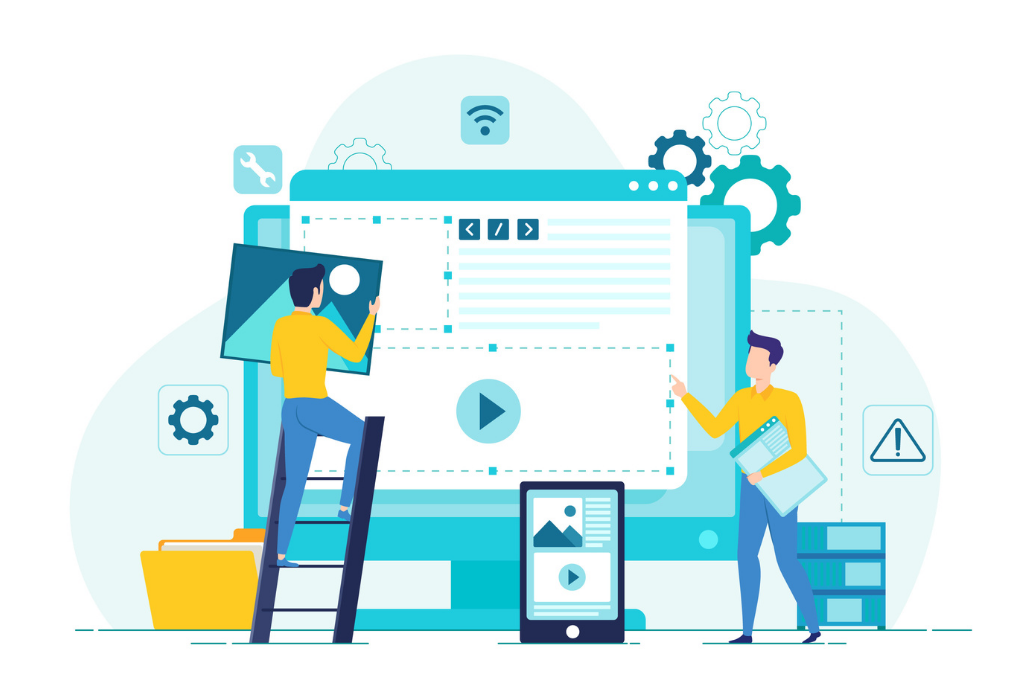Last updated on 12th November 2021.
The software industry is evolving at breakneck speed with enormous jargon and buzzwords trending. Businesses often face hardships to survive in this competitive environment.
Modern enterprises are steering in the age of digitally aware users. It is the reason most companies worldwide are adopting a strategic approach to enterprise software development.
According to Statista, 66% of enterprise resource planning implementation projects experienced cost overruns between 2010 and 2020.
In this article, we are going to help you understand the detailed analysis of enterprise software development. But before we move on, let us first look into how Enterprise software benefits businesses, the development process, how much cost it involves, and how it contributed to the positive outlook in the industry.
Business owners don’t need to rely on multiple programs for different processes and massive data migration processes.
To eliminate this bottleneck, organizations develop enterprise software to integrate and collaborate all the tools and technologies required in managing a business of external and internal operations.
Defining Enterprise Software Development
Enterprise software development is developing an application or platform that solves critical problems and contains functionalities that reduce inefficiencies, streamline communication within the company, and ultimately enhance the employees’ lives.
Enterprise application software is an intelligent way to gain unified control over your organization. It facilitates businesses with a structured work environment and streamlines operations. Some key benefits include:
- Seamless flow of information and data sharing
- Simplified IT processes
- Reduces costs related to software maintenance and upkeep
- Better adaptation to market shifts
- Increased operational efficiency
Read also: A Handbook To Successful Software Development Practices in 2021
Features Of Enterprise Software
Enterprise Software Development has certain aspects that characterize it. Here are some characteristics that enterprise software owns.
Performance
Enterprise software is quite demanding in the software industry. Companies never compromise with the performance of the software built as it is used by a myriad of users on different kinds of devices, ranging from desktops to mobiles. The high demand and excellent performance make software prevailing in the market. This is why the testing and quality control stage is highly crucial in enterprise software development to avoid any hindrance.
Scalability
Scalability defines the quality any software product holds. A less or no scalable product will deteriorate and be out of the market in time.
Scalability determines the growth and advancement of any software, functionality, features, and any aspect necessary. This growth should not affect the performance of the enterprise software.
Security
Security is the most critical concern in the realm of enterprise development when crafting sophisticated software solutions.
It highly requires vast investment, specialists, and in-depth analysis of the loopholes in software developed. Here we are talking about cybersecurity for the employees or users who use it, the information it handles, and security for all the devices that make up this network.
Cyberattacks are increasingly harmful and not only compromise information but also infrastructure.
Read also: 5 Reasons Why You Should Choose Zend Framework for Enterprise Application Development
Cost
The cost in developing enterprise software includes development cost, maintenance costs to the MVP pre-launch, and finally, full-fledged product launch in the market.
In established enterprises, cost controls are rigid it may lead to severe consequences for the company’s development. So they take all cost control measures to eliminate or reduce the software budget.
Robustness
The enterprise software not only develops with robust, proven, reliable, and secure technology. It must also comply with minimum security standards; it must be compatible, versionable, easy to access, and managed by authorized persons. It must record the activities and processes and several qualities that make it a robust software.
Storage
This characteristic is highly critical to handle when it comes to enterprise software development. It involves the bulk of information stored at multiple places that need to be segregated to monitor the software to ensure its flawless functionality is frequently used for different processes. There are many options experts considered today for data storage while developing enterprise software.
Types Of Enterprise Software
Enterprise software development facilitates companies with managing, storing, and transferring complex data. You can now automate critical processes that access massive data seamlessly. There are many enterprise software available in the market, such as Human Resource Management (HRM), There are various types of enterprise software for human resources in the market, including Human Resource Management (HRM) solutions. Marketing Automation, Business Process Management, etc.
The functionalities and features they provide make the company development processes more accessible and faster but also help users to create their routine tasks simpler by using these systems.
Now, let’s take a look at the three leading enterprise software.
-
Customer Relationship Management (CRM)
-
Enterprise Resource Planning (ERP)
-
Supply Chain Management (SCM)
Customer Relationship Management
Customer Relationship Management (CRM) combines strategies, practices, and technologies that big companies use to quickly manage and analyze customer interactions. CRM is highly crucial when it comes to customer retention and improves customer service relationships. The massive data present is managed seamlessly throughout the entire customer lifecycle. Also by integrating effective customer database software enhances the organization and accessibility of customer data, further optimizing CRM processes
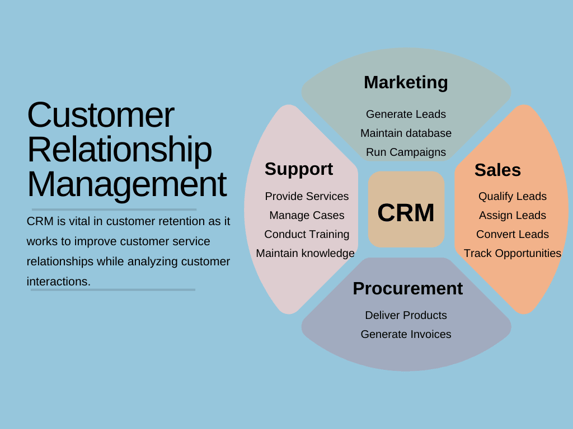
Here why do businesses choose CRM?
- Get real customer insights through real-time reporting and visualization features.
- Provide better and faster customer support service with accessible customer information
- Automate sales funnel activities
CRM systems work great when business processes involve customer interactions to enhance the customer experience.
You can use small business CRM Software to manage your team and increase productivity.
Enterprise Resource Planning
Enterprise Resource Planning (ERP) system facilitates managing internal processes that run seamlessly within a corporation. With enterprise software operational, every department has its systems optimized for department-exclusive tasks. They can communicate and share information with others faster. Below mentioned are some benefits that companies make using ERP systems.
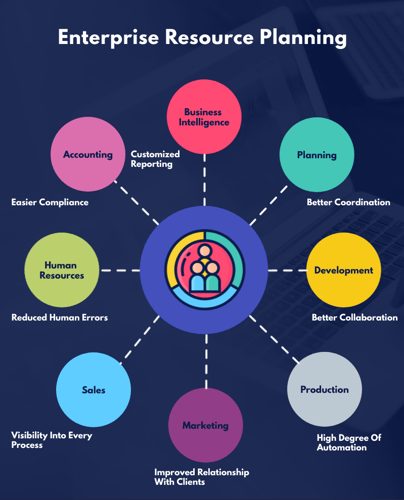
- Share information across different departments and to the rest of the company
- Eliminate similar and inefficient technology
This software facilitates sharing of data and integrated functions across different systems.
Supply Chain Management Systems
SCM mainly deals with supply chains. The enterprise software manages the flow of goods and services across all departments. It includes any process that transforms raw materials into final products. SCM keeps business operations efficient and economical.
Size of the global supply chain management market worldwide from 2019 to 2027
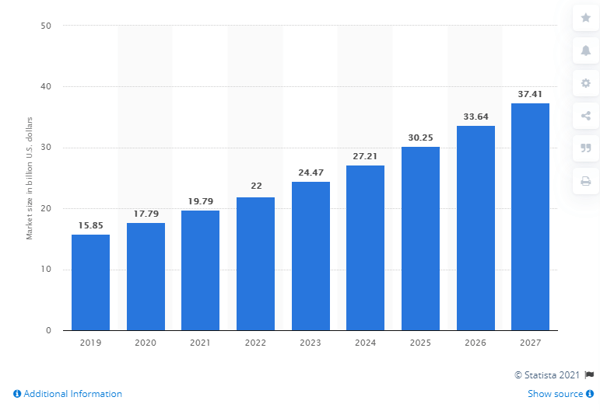
Businesses use this enterprise software to:
-
Streamline activities
-
Maximize customer value
-
Gain a competitive advantage in the marketplace
-
Cut additional costs
-
Faster delivery of products to consumers
The development of Supply Chain Management Systems is vital in staying ahead of the changing trends. Businesses can now build seamless software that serves their best interests.
Why Enterprise Software Is Important To Businesses?
The benefit of enterprise software is simply automating the daily processes of an organization seamlessly. Let’s check out some reasons why businesses invest in enterprise software development.
A. Streamlined Processes
The modern ERP systems are designed to bring all the data together, ultimately improving the business process bottlenecks.
The benefits here you get–
- Centralized Data
- Produces Opportunity for Automation of Workflow
B. Better Tracing and Control
The ERP systems can offer a straightforward approach to track your outcomes if your business deals in digital or physical products. It helps to trace how services and products are moving in the pipeline.
Popular enterprise software vendors offer tools that are well proficient in order tracking, revenue tracking, inventory, tracking, and raw material management.
Read also: Top 10+ Software Development Companies To Watch Out In 2021
C. Advanced Customer Service
Providing advanced customer service is one of the reasons why companies invest in enterprise software development. It leads to a significant change in their customer service domain offerings.
Your customer service domain can be more efficient through the ERP system.
- Better Aligned Suppliers and Customers
- Prioritized Valuable Customers
Step-By-Step Process To Enterprise Software Development
Implementing enterprise software in your business, if performed right, can take your business to great heights, but when implemented wrong, it can turn your planned process into a complex one.
Let’s have a look at the process.
1. Prepare A Blueprint
Before starting with enterprise software development, prepare a detailed plan that includes your project plans, schedules and timelines, cost estimation, and other software requirements.
-
Project Plan: Draft a detailed plan of the enterprise software you want to build on paper. The project plan will help identify the development tools, programming languages/frameworks, and platforms to shape the software’s outlook.
-
Schedules and Timelines: Set realistic deadlines and take the skilled professionals on board. This will depict how much time it will take to deliver the software.
-
Cost Estimation and Budgeting: Before setting the project mode on, it’s essential to make sure the software is affordable and pocket-friendly.
-
Software Requirements: Prepare a list of things you are required to start your development. It includes personnel, tools, hardware, and other resources.
2. Assess Project Requirements
In this stage, you need to ensure that all the software requirements are listed and understood by all stakeholders. You schedule meetings with the team to help them understand the timeline, resources required, and other software elements. Prepare a formal document with the required details and collect as much information as possible.
You can assess your project requirements holistically:
- Analyze the existing software
- Conduct sessions and meetings with users and developers
- Collect user information via surveys, contests, questionnaires
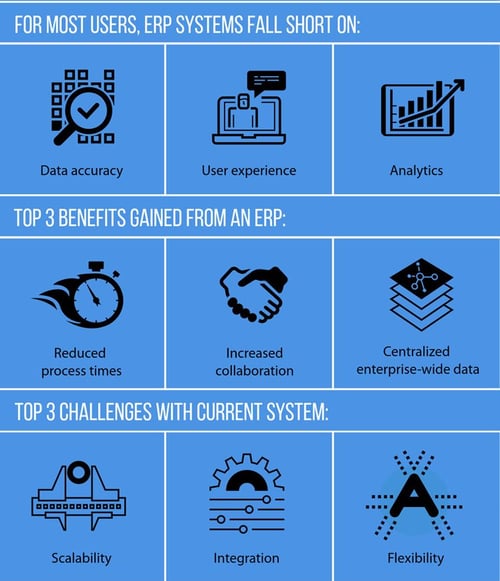
3. Choose The Right Technology
To build enterprise software, you should pick the right tech toolkit for developers:
-
Most enterprises today host an ERP system in the cloud or on the local server. It is considered more secure.
-
Select the correct programming language for developing enterprise software. JavaScript frameworks are considered perfect for frontend development and Node.js for the backend.
-
Choose a reliable database for storing massive data. Relational/SQL databases go perfect for small businesses that have an enormous demand for standardization.
4. Search For A Skilled Team
Finding the right pool of talent for implementing enterprise software development is challenging. The team of professionals who would handle the whole process smartly and efficiently should be a priority. The team of specialist ERP implementation experts manages the evolution challenges, data migration, and transitional period.
You need a skilled professional team consisting of:
- Project Managers
- Analysts
- QA Engineer
- Consultants
5. Software Design
Most software projects are either not well-planned or not well-executed. When designing and developing, make sure your plan is realistic and interactive.
Now that you have the software requirements listed, the design process will be an easy cakewalk. The input you’ve gathered will help you plan the software just according to your business requirements. Before finalizing your design, create a prototype first and share them with all the stakeholders for approval. The architecture of the software might be complicated yet straightforward.
6. Software Development
Developing enterprise software is a matter of finding the right balance between software excellence and business value. Any wrong decision can make things go down the wrong path.
Once you get finalized with your development tools and software design, it’s time to develop the software. The developers can now start coding according to the SRS (software requirement specification) of the project. It is important not to end up development phase in a hurry, leaving some barriers or loopholes.
Read also: Why use Drupal for Enterprise Content Management?
7. Software Testing
Before you deliver the final software to clients, make sure to test the software thoroughly. Test the software on different aspects to eliminate errors and bugs. There are various software tests to ensure the flawless functionality of the software.
-
Code Quality: Minimizes bugs and crashes to get crystal clear code that is readable and easy to alter whenever required.
-
Unit Testing: This test determines various components to validate each software unit is functioning as expected.
-
Integration Testing: This testing reveals any bugs or loopholes in the interaction between integrated units. All units are tested to ensure smooth performance.
-
Performance Testing: This test eliminates the performance bottlenecks of the software. Coders then check the speed, response time, reliability, resource usage, scalability of the software under the expected workload. Also, they ensure that the software must run smoothly, even if multiple users are accessing it simultaneously.
-
Security Testing: Developers run security testing to expose any threats, vulnerabilities, or risks that are dangerous. It detects security risks in the software that is fixed by coding.
After the successful completion of the testing phase, your software is now ready for deployment.
8. Software Deployment
At this stage, your enterprise software is now ready for market launch. The deployment phase is all about getting manual approval to deploy the software.
Some companies make use of automated tools to deploy the software, such as Application Release Automation (ARA). Once accessible to employees, you must teach them how to use the software. At this stage, you will get the smooth release of your newly developed enterprise software.
9. Support and Maintenance
After a successful launch, you need to monitor the software to ensure its flawless functionality frequently. The software can be updated and altered as per user feedback because there is always some space for improvement.
Regular checks will also disclose any bugs and defects of the software that might be hindering its performance. In addition to identifying those bugs, removing them is essential to prevent problems in the software.
Cost Deciding Factors Of Enterprise Software Development
Several different factors directly impact enterprise software development costs. Let’s have a look at them:
Users and Applications
The first enterprise software cost-affecting factor is the number of users working around it and the many ways they will be using it. The more features you add, the greater would be the overall software development cost.
Software Add-ins
To offer a comprehensive range of services and functionalities to your employees, you will have several third-party add-ins like Enterprise IMs tool or social media logins or an enabling scanning barcode.
Implementation Cost
Adding your ERP system to your legacy system or simply adding a fresh approach. These testing aims would require a lot of time and effort, along with resource requirements.
Maintenance
Until you are investing in a cloud-based ERP solution, your on-premise system will require frequent and timely maintenance to ensure that the product is up to date and running as expected at all times.
Training
Provide the detailing of the enterprise software to your entire team. The training is not only the investment of your time but also a percent of your expense share.
Upgrades
When a revised version of your enterprise solution announced, you will have to start planning the upgrade yourself. Eliminate the old issues and bugs in the enterprise software.
Technology Additions
The cost of your enterprise software will automatically increase with the integration of trending technologies. The more technologies you integrate into the enterprise solution, like Blockchain, Artificial Intelligence, or IoT, the greater your cost estimate.
Resource Requirements
The resources required to handle your entire enterprise software development, from planning to deployment, also add to the cost of the Enterprise Resource Planning system.
Apart from this, the pricing model is another factor that decides the enterprise software development cost.
In A Nutshell
Enterprise software development is a never-ending iterative process. There is no perfect method for developing enterprise software applications. For this, you need to assess your business requirements and follow the best practices that perfectly fit your business needs.
We hope you understand the enterprise software process and its benefits will make your software development life cycle faster and easier.
This article will give you a promising kick startup to start your next enterprise software development project.













